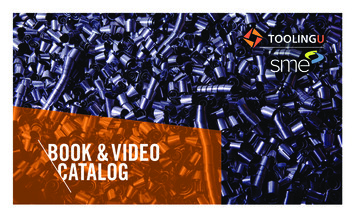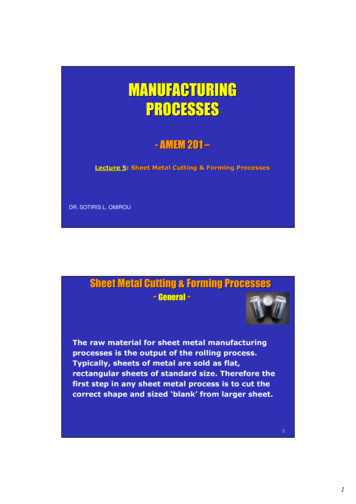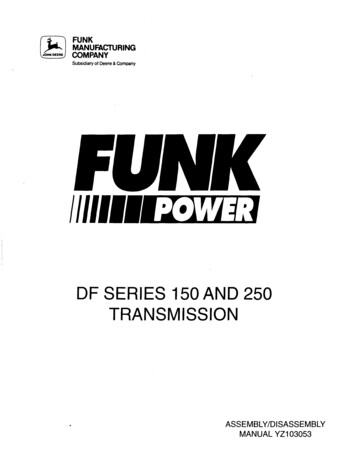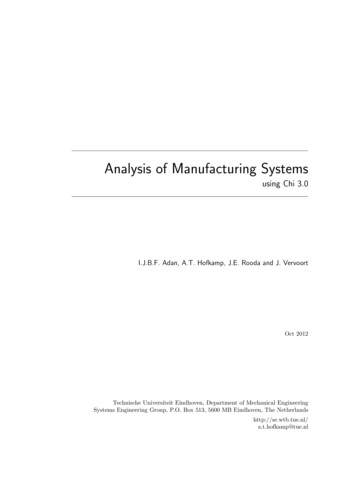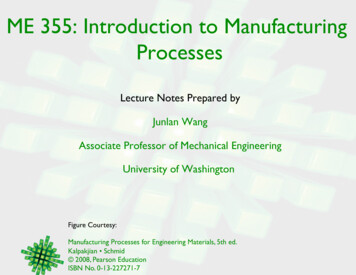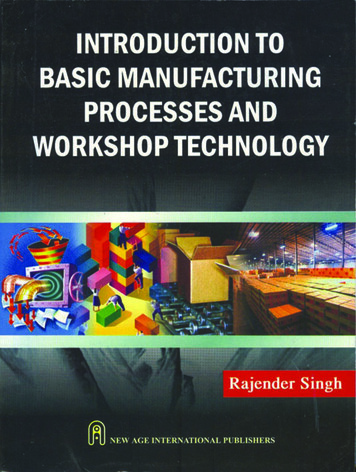
Transcription
THIS PAGE ISBLANK
Copyright 2006 New Age International (P) Ltd., PublishersPublished by New Age International (P) Ltd., PublishersAll rights reserved.No part of this ebook may be reproduced in any form, by photostat, microfilm,xerography, or any other means, or incorporated into any information retrievalsystem, electronic or mechanical, without the written permission of the publisher.All inquiries should be emailed to rights@newagepublishers.comISBN (10) : 81-224-2316-7ISBN (13) : 978-81-224-2316-7PUBLISHING FOR ONE WORLDNEW AGE INTERNATIONAL (P) LIMITED, PUBLISHERS4835/24, Ansari Road, Daryaganj, New Delhi - 110002Visit us at www.newagepublishers.com
DedicatedtoMy Father Late Shri Sada Ram
THIS PAGE ISBLANK
PREFACEManufacturing and workshop practices have become important in the industrial environment to produce products for the service of mankind. The knowledge of manufacturingpractices is highly essential for all engineers and technocrats for familiarizing themselveswith modern concepts of manufacturing technologies. The basic need is to provide theoretical and practical knowledge of manufacturing processes and workshop technology to all theengineering students. Therefore, an attempt has been made through this book to presentboth the theoretical and practical knowledge of these subjects. Considering the generalneeds of engineering students in the country and the fact that they hardly get any exposureto hand tools, equipments, machines and manufacturing setups, a basic course in manufacturing science remains a core subject for all the branches of engineering. This book coversmost of the syllabus of manufacturing processes/technology, workshop technology and workshop practices for engineering diploma and degree classes prescribed by different universities and state technical boards. While preparing the manuscript of this book, the examination requirements of the engineering students have also been kept in mind. The book iswritten in very simple language so that even an average student can easily grasp the subjectmatter. Some comparisons have been given in tabular form and the stress has been givenon figures for better understanding of tools, equipments, machines and manufacturing setups used in various manufacturing shops. The contents include exposure to bench work andfitting, smithy and forging, sheet metal work, wood and wood working, casting, welding andmachine shop practices. At the end of each chapter, a number of questions have beenprovided for testing the student’s understanding about the concept of the subject. The wholetext has been organized in twenty six chapters.The first chapter presents the brief introduction of the subject with modern conceptsof manufacturing technology needed for the competitive industrial environment. Chapter 2provides the necessary details of plant and shop layouts. General industrial safety measuresto be followed in various manufacturing shops are described in detail in chapter 3.Chapters 4–8 provide necessary details regarding fundamentals of ferrous materials,non-ferrous materials, melting furnaces, properties and testing of engineering materials andheat treatment of metals and alloys.Chapters 9–13 describe various tools, equipments and processes used in various shopssuch as carpentry, pattern making, mold and core making, foundry shop. Special castingmethods and casting defects are also explained at length.Chapters 14–16 provide basic knowledge of mechanical working of metals. Fundamentalconcepts related to forging work and other mechanical working processes (hot and coldworking) have been discussed at length with neat sketches.
(viii)Chapter 17 provides necessary details of various welding and allied joining processessuch as gas welding, arc welding, resistance welding, solid state welding, thermochemicalwelding, brazing and soldering.Chapters 18–19 describe sheet metal and fitting work in detail. Various kinds of handtools and equipments used in sheet metal and fitting shops have been described using neatsketches.Chapters 20–24 provide construction and operational details of various machine toolsnamely lathe, drilling machine, shaper, planer, slotter, and milling machine with the helpof neat diagrams.Chapter 25 deals with technique of manufacturing of products with powder metallurgy.The last chapter of the book discusses the basic concepts of quality control and inspectiontechniques used in manufacturing industries.The author strongly believes that the book would serve not only as a text book for thestudents of engineering curriculum but would also provide reference material to engineersworking in manufacturing industries.Although every care has been taken to check misprints and mistakes, yet it is difficultto claim perfection. Any errors, omissions and suggestions for improvement of this volumewill be thankfully acknowledged and included in the next edition.RAJENDER SINGH
ACKNOWLEDGEMENTOn completion of the book ‘Introduction to Basic ManufacturingProcesses and Workshop Technology’, foremost I acknowledge the graceof God; and the blessing of my father late Sh. Sada Ram, my mother Smt.Sona Devi, my respected teacher Prof. G.S. Sekhon and my elders. I wish toacknowledge my sincere thanks to Sh. Shailendra Kumar, lecturer in HinduCollege of Engineering, Sonepat, Haryana for assisting me at various stagesduring preparation of the manuscript. I also acknowledge the students andcolleagues whose association has given me the experience of teaching thisand related subjects and hence the manuscript of this book could be possible.I am very happy to record my sense of gratitude to my wife Promilla, daughter Swati and son Ravi Kant for their patience, understanding and moralsupport without which it would have not been possible for me to completethis book.Finally, I am thankful to our publisher, New Age International (P) Ltd.Publishers for bringing out the book in a record time and such a nice format.RAJENDER SINGH
THIS PAGE ISBLANK
CONTENTSPreface(vii)Acknowledgements(ix)1. Introduction12. Plant and Shop Layout173. Industrial Safety264. Ferrous Materials515. Non-Ferrous Materials766. Melting Furnaces1027. Porperties and Testing of Metals1168. Heat Treatment1309. Carpentry15210. Pattern and Core Making17911. Foundry Tools and Equipments19712. Mold and Core Making20813. Casting24114. Forging26015. Hot Working of Metals28216. Cold Working29317. Welding30618. Sheet Metal Work34819. Fitting36420. Metal Cutting39721. Lathe Machine40622. Drilling Machine42223. Shaper, Planer and Slotter43424. Milling44725. Powder Metallurgy45826. Inspection and Quality Control466Index475
THIS PAGE ISBLANK
1CHAPTERINTRODUCTION1.1INTRODUCTIONManufacturing is the backbone of any industrialized nation. Manufacturing and technical staffin industry must know the various manufacturing processes, materials being processed, toolsand equipments for manufacturing different components or products with optimal processplan using proper precautions and specified safety rules to avoid accidents. Beside above, allkinds of the future engineers must know the basic requirements of workshop activities interm of man, machine, material, methods, money and other infrastructure facilities neededto be positioned properly for optimal shop layouts or plant layout and other support serviceseffectively adjusted or located in the industry or plant within a well planned manufacturingorganization.The complete understanding of basic manufacturing processes and workshop technologyis highly difficult for any one to claim expertise over it. The study deals with several aspectsof workshops practices also for imparting the basic working knowledge of the differentengineering materials, tools, equipments, manufacturing processes, basic concepts of electromechanical controls of machine tools, production criteria’s, characteristics and uses of varioustesting instruments and measuring or inspecting devices for checking components or productsmanufactured in various manufacturing shops in an industrial environment. It also describesand demonstrates the use of different hand tools (measuring, marking, holding and supportingtools, cutting etc.), equipments, machinery and various methods of manufacturing that facilitateshaping or forming the different existing raw materials into suitable usable forms. It dealswith the study of industrial environment which involves the practical knowledge in the areaof ferrous and non ferrous materials, their properties and uses. It should provide the knowledgeof basic workshop processes namely bench work and fitting, sheet metal, carpentry, patternmaking, mould making, foundry, smithy, forging, metal working and heat treatment, welding,fastening, machine shop, surface finishing and coatings, assembling inspection and qualitycontrol. It emphasizes on basic knowledge regarding composition, properties and uses ofdifferent raw materials, various production processes, replacement of or improvement overa large number of old processes, new and compact designs, better accuracy in dimensions,quicker methods of production, better surface finishes, more alternatives to the existingmaterials and tooling systems, automatic and numerical control systems, higher mechanizationand greater output.1
2 Introduction to Basic Manufacturing Processes and Workshop Technology1.2SCOPE OF STUDYToday’s competitive manufacturing era of high industrial development and research, is beingcalled the age of mechanization, automation and computer integrated manufacturing. Due tonew researches in the manufacturing field, the advancement has come to this extent thatevery different aspect of this technology has become a full-fledged fundamental and advancedstudy in itself. This has led to introduction of optimized design and manufacturing of newproducts. New developments in manufacturing areas are deciding to transfer more skill to themachines for considerably reduction of manual labor. The scope of the subject of workshoptechnology and manufacturing practices is a extremely wide as it specifies the need of greatercare for man, machine, material and other equipments involving higher initial investment byusing proper safety rule and precautions. The through and deep knowledge in the course ofstudy of this important subject is therefore becoming essential for all kinds of engineers tohave sound foundation in their profession. Therefore the course of study of this subjectprovides a good theoretical background and a sound practical knowledge to the engineeringstudents and workshop staff. One should also be aware of the following terms for betterunderstanding of the scope of the study1.3MANUFACTURING ENGINEERINGManufacturing is derived from the Latin word manufactus, means made by hand. In moderncontext it involves making products from raw material by using various processes, by makinguse of hand tools, machinery or even computers. It is therefore a study of the processesrequired to make parts and to assemble them in machines. Process Engineering, in itsapplication to engineering industries, shows how the different problems related to developmentof various machines may be solved by a study of physical, chemical and other laws governingthe manufacturing process. The study of manufacturing reveals those parameters which canbe most efficiently being influenced to increase production and raise its accuracy. Advancemanufacturing engineering involves the following concepts—1. Process planning.2. Process sheets.3. Route sheets.4. Tooling.5. Cutting tools, machine tools (traditional, numerical control (NC), and computerizednumerical control (CNC).6. Jigs and Fixtures.7. Dies and Moulds.8. Manufacturing Information Generation.9. CNC part programs.10. Robot programmers.11. Flexible Manufacturing Systems (FMS), Group Technology (GT) and Computerintegrated manufacturing (CIM).1.4PRODUCTION PROCESSIt is the process followed in a plant for converting semi- finished products or raw materialsinto finished products or raw materials into finished products. The art of converting raw
Introduction 3material into finished goods with application of different types of tools, equipments, machinetools, manufacturing set ups and manufacturing processes, is known as production. Generallythere are three basic types of production system that are given as under.1.Job production2.Batch production3.Mass productionJob production comprises of an operator or group of operators to work upon a single joband complete it before proceeding to the next similar or different job. The productionrequirement in the job production system is extremely low. It requires fixed type of layoutfor developing same products.Manufacturing of products (less in number say 200 to 800) with variety of similar partswith very little variation in size and shape is called batch production. Whenever the productionof batch is over, the same manufacturing facility is used for production of other batch productor items. The batch may be for once or of periodical type or of repeated kinds after someirregular interval. Such manufacturing concepts are leading to GT and FMS technology.Manufacturing of products in this case requires process or functional layout.Where as mass production involves production of large number of identical products (saymore than 50000) that needs line layout type of plant layout which is highly rigid type andinvolves automation and huge amount of investment in special purpose machines to increasethe production.1.5PROCESS PLANNINGProcess planning consists of selection of means of production (machine-tools, cutting tools,presses, jigs, fixtures, measuring tools etc.), establishing the efficient sequence of operation,determination of changes in form, dimension or finish of the machine tools in addition to thespecification of the actions of the operator. It includes the calculation of the machining time,as well as the required skill of the operator. It also establishes an efficient sequence ofmanufacturing steps for minimizing material handling which ensures that the work will bedone at the minimum cost and at maximum productivity. The basic concepts of processplanning are generally concerned with the machining only. Although these concepts may alsobe extended to other processes such as casting, forging, sheet metal forming, assembling andheat treatment as well.1.6MANUFACTURING PROCESSManufacturing process is that part of the production process which is directly concernedwith the change of form or dimensions of the part being produced. It does not include thetransportation, handling or storage of parts, as they are not directly concerned with thechanges into the form or dimensions of the part produced.1.7CLASSIFICATION OF MANUFACTURING PROCESSESFor producing of products materials are needed. It is therefore important to know thecharacteristics of the available engineering materials. Raw materials used manufacturing ofproducts, tools, machines and equipments in factories or industries are extracted from ores.The ores are suitably converted the metal into a molten form by reducing or refining processes
4 Introduction to Basic Manufacturing Processes and Workshop Technologyin foundries. This molten metal is poured into moulds for providing commercial castings,called ingots. Such ingots are then processed in rolling mills to obtain market form ofmaterial supply in form of bloom, billets, slabs and rods. These forms of material supply arefurther subjected to various manufacturing processes for getting usable metal products ofdifferent shapes and sizes in various manufacturing shops. All these processes used inmanufacturing concern for changing the ingots into usable products may be classified into sixmajor groups as primary shaping processes, secondary machining processes, metal formingprocesses, joining processes, surface finishing processes and processes effecting change inproperties. These are discussed as under.1.7.1 Primary Shaping ProcessesPrimary shaping processes are manufacturing of a product from an amorphous material.Some processes produces finish products or articles into its usual form whereas others do not,and require further working to finish component to the desired shape and size. Castings needre-melting of scrap and defective ingots in cupola or in some other melting furnace and thenpouring of the molten metal into sand or metallic moulds to obtain the castings. Thus theintricate shapes can be manufactured. Typical examples of the products that are produced bycasting process are machine beds, automobile engines, carburetors, flywheels etc. The partsproduced through these processes may or may not require to under go further operations.Some of the important primary shaping processes is:(1) Casting, (2) Powder metallurgy, (3) Plastic technology, (4) Gas cutting, (5) Bending and(6) Forging.1.7.2. Secondary or Machining ProcessesAs large number of components require further processing after the primary processes. Thesecomponents are subjected to one or more number of machining operations in machine shops,to obtain the desired shape and dimensional accuracy on flat and cylindrical jobs. Thus, thejobs undergoing these operations are the roughly finished products received through primaryshaping processes. The process of removing the undesired or unwanted material from theworkpiece or job or component to produce a required shape using a cutting tool is known asmachining. This can be done by a manual process or by using a machine called machine tool(traditional machines namely lathe, milling machine, drilling, shaper, planner, slotter). Inmany cases these operations are performed on rods, bars and flat surfaces in machine shops.These secondary processes are mainly required for achieving dimensional accuracy and a veryhigh degree of surface finish. The secondary processes require the use of one or moremachine tools, various single or multi-point cutting tools (cutters), job holding devices, markingand measuring instruments, testing devices and gauges etc. for getting desired dimensionalcontrol and required degree of surface finish on the workpieces. The example of parts producedby machining processes includes hand tools machine tools instruments, automobile parts,nuts, bolts and gears etc. Lot of material is wasted as scrap in the secondary or machiningprocess. Some of the common secondary or machining processes are—(1) Turning, (2) Threading, (3) Knurling, (4) Milling, (5) Drilling, (6) Boring, (7) Planning,(8) Shaping, (9) Slotting, (10) Sawing, (11) Broaching, (12) Hobbing, (13) Grinding, (14) Gearcutting, (15) Thread cutting and (16) Unconventional machining processes namely machiningwith Numerical Control (NC) machines tools or Computer Numerical Control (CNC) machinestools using ECM, LBM, AJM, USM setups etc.
Introduction 51.7.3 Metal Forming ProcessesForming processes encompasses a wide variety of techniques, which make use of suitableforce, pressure or stresses, like compression, tension and shear or their combination to causea permanent deformation of the raw material to impart required shape. These processes arealso known as mechanical working processes and are mainly classified into two major categoriesi.e., hot working processes and cold working processes. In these processes, no material isremoved; however it is deformed and displaced using suitable stresses like compression,tension, and shear or combined stresses to cause plastic deformation of the materials toproduce required shapes. Such processes lead to production of directly usable articles whichinclude kitchen utensils, rods, wires, rails, cold drink bottle caps, collapsible tubes etc. Someof the important metal forming processes are:Hot working Processes(1) Forging, (2) Rolling, (3) Hot spinning, (4) Extrusion, (5) Hot drawing and (6) Hot spinning.Cold working processes(1) Cold forging, (2) Cold rolling, (3) Cold heading, (4) Cold drawing, (5) Wire drawing,(6) Stretch forming, (7) Sheet metal working processes such as piercing, punching, lancing,notching, coining, squeezing, deep drawing, bending etc.1.7.4 Joining ProcessesMany products observed in day-to-day life, are commonly made by putting many parts togethermay be in subassembly. For example, the ball pen consists of a body, refill, barrel, cap, andrefill operating mechanism. All these parts are put together to form the product as a pen.More than 800 parts are put together to make various subassemblies and final assembly ofcar or aero-plane. A complete machine tool may also require to assemble more than 100 partsin various sub assemble or final assembly. The process of putting the parts together to formthe product, which performs the desired function, is called assembly. An assemblage of partsmay require some parts to be joined together using various joining processes. But assemblyshould not be confused with the joining process. Most of the products cannot be manufacturedas single unit they are manufactured as different components using one or more of the abovemanufacturing processes, and these components are assembled to get the desired product.Joining processes are widely used in fabrication and assembly work. In these process two ormore pieces of metal parts are joined together to produce desired shape and size of theproduct. The joining processes are carried out by fusing, pressing, rubbing, riveting, screwingor any other means of assembling. These processes are used for assembling metal parts andin general fabrication work. Such requirements usually occur when several pieces are to bejoined together to fabricate a desired structure of products. These processes are used developingsteam or water-tight joints. Temporary, semi-permanent or permanent type of fastening tomake a good joint is generally created by these processes. Temporary joining of componentscan be achieved by use of nuts, screws and bolts. Adhesives are also used to make temporaryjoints. Some of the important and common joining processes are:(1) Welding (plastic or fusion), (2) Brazing, (3) Soldering, (4) Riveting, (5) Screwing,(6) Press fitting, (7) Sintering, (8) Adhesive bonding, (9) Shrink fitting, (10) Explosive welding,(11) Diffusion welding, (12) Keys and cotters joints, (13) Coupling and (14) Nut and bolt joints.1.7.5 Surface Finishing ProcessesSurface finishing processes are utilized for imparting intended surface finish on the surfaceof a job. By imparting a surface finishing process, dimension of part is not changed functionally;
6 Introduction to Basic Manufacturing Processes and Workshop Technologyeither a very negligible amount of material is removed from the certain material is added tothe surface of the job. These processes should not be misunderstood as metal removingprocesses in any case as they are primarily intended to provide a good surface finish or adecorative or protective coating on to the metal surface. Surface cleaning process also calledas a surface finishing process. Some of the commonly used surface finishing processes are:(1) Honing, (2) Lapping, (3) Super finishing, (4) Belt grinding, (5) Polishing, (6) Tumbling,(7) Organic finishes, (8) Sanding, (9) deburring, (10) Electroplating, (11) Buffing, (12) Metalspraying, (13) Painting, (14) Inorganic coating, (15) Anodizing, (16) Sheradising, (17) Parkerizing,(18) Galvanizing, (19) Plastic coating, (20) Metallic coating, (21) Anodizing and (22) Sand blasting.1.7.6 Processes Effecting Change in PropertiesProcesses effecting change in properties are generally employed to provide certain specificproperties to the metal work pieces for making them suitable for particular operations or use.Some important material properties like hardening, softening and grain refinement are neededto jobs and hence are imparted by heat treatment. Heat treatments affect the physicalproperties and also make a marked change in the internal structure of the metal. Similarlythe metal forming processes effect on the physical properties of work pieces Similarly shotpeening process, imparts fatigue resistance to work pieces. A few such commonly used processesare given as under:(1) Annealing, (2) Normalising, (3) Hardening, (4) Case hardening, (5) Flame hardening,(6) Tempering, (7) Shot peeing, (8) Grain refining and (9) Age hardening.In addition, some allied manufacturing activities are also required to produce the finishedproduct such as measurement and assembly.1.8. PRODUCT SIMPLIFICATION AND STANDARDISATIONThe technique of simplification and standardization of product is closely inter-related thatleads to higher efficiency in production, better quality and reduced production cost. Simplificationis a process of determining limited number of grades, types and sizes of a components orproducts or parts in order to achieve better quality control, minimize waste, simplify productionand, thus, reduce cost of production. By eliminating unnecessary varieties, sizes and designs,simplification leads to manufacture identical components or products for interchangeabilityand maintenance purposes of assembly of parts. Standardization is the important step towardsinterchangeable manufacture, increased output and higher economy. The technique ofstandardization comprises of determining optimal manufacturing processes, identifying thebest possible engineering material, and allied techniques for the manufacture of a product andadhering to them very strictly so long as the better standards for all these are not identified.Thus definite standards are set up for a specified product with respect to its quality, requiredequipment, machinery, labor, material, process of manufacture and the cost of production.The identified standard with time for a specified product should never be taken as final forever because improvement is always possible. It must accommodate the outcome of all thenew researches in the manufacturing areas in order to keep pace with increasing globalcompetition. Improvements over the existing standards in all respects should always bewelcomed. The different standards prevailing in different industries may be of the types ofmanagerial, design, manufacturing and technical needs. Managerial standards are applicableto administrative functions within industry. These include the company policy, accountingprocedures, personnel policies, performance evaluation, control of expenditures, safety aspects,
Introduction 7security procedures and regulations, etc. where as design, manufacturing and technical standardsare needed for manufacturing concepts of the industry. These include design and manufacturingtechniques, practices, materials and parts, supplies, methods of testing, drafting method,abbreviations and symbols, specifications and nomenclature, etc.1.9INSPECTION AND QUALITY CONTROLA product is manufactured to perform desired functions. It must have a specified dimensionsuch as length, width, height, diameter and surface smoothness to perform or accomplish itsintended function. It means that each product requires a defined size, shape and othercharacteristics as per the design specifications. For manufacturing the product to the specifiedsize, the dimensions should be measured and checked during and after the manufacturingprocess. It involves measuring the size, smoothness and other features, in addition to theirchecking. These activities are called measurement and inspection respectively.In the era of globalization, every industry must pay sufficient attention towards maintainingquality because it is another important requirement or function of a production unit. If amanufacturing concern wants to survive for longer time and to maintain its reputation amongthe users, it should under all condition apply enough efforts not only to keep up the standardof quality of its products once established but to improve upon the same from time to time.For this, every manufacturing concern must maintain a full-fledged inspection and qualitycontrol department which inspects the product at different stages of its production. Vigilantinspection of raw materials and products depends upon the entire process of standardization.The production unit of manufacturing concern must produce identical products. However aminor variation may be allowed to a predetermined amount in their finished dimensions ofthe products. The two extremities of dimensions of the product are called limits. All the partsof which the finished dimensions lie within these limits are acceptable parts. This facilitateseasy and quicker production, easy inspection, requires less skill on the part of worker andaccommodates a slight inaccuracy in the machine as well, resulting in an over all reductionin the production cost of the part.1.10 MECHANIZATION AND AUTOMATIONMechanization means something is done or operated by machinery and not by hand.Mechanization of the manufacturing means is milestone oriented trend towards minimizingthe human efforts to the extent of its possibility, by adopting mechanical and electrical meansor methods for automating the different manufacturing processes. Such a trend may be in thearea of automating and mechanizing the processes of material handling, loading and unloadingof components, actual operations performed on the job or transportation, etc. But, no feedbackis provided by the process, operation or machinery. Extension of mechanization of the productionprocess is termed as automation and it is controlled by a closed loop system in which feedbackis provided by the sensors. It controls the operations of different machines automatically. Theautomatic control may be applied for some operations or for all the operations of a machineor group of machines. Accordingly the machine will be known as semi-automatic or fullyautomatic. The term was identified shortly after the World War II at the Ford Motor Companyto describe the automatic handling of materials and parts between the process operations.The word ‘automation’ is derived fr
Manufacturing is the backbone of any industrialized nation. Manufacturing and technical staff in industry must know the various manufacturing processes, materials being processed, tools and equipments for manufacturing different components or products with optimal process plan using proper p
